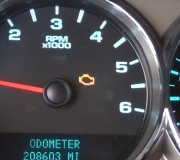Dandy. A failure of the motor itself is by far the least common cause of low idle, but it can happen. If that happened to me, I would assume I overlooked a stretched connector terminal, or one that was corroded. I would second-guess myself, even after the problem was solved.
For future reference, you don't have to do the relearn procedure when you replace this motor, or any other part. On most brands of cars that use this type of idle speed control system, the Engine Computer is not interested in the step number it has placed the motor at. It is simply concerned with whether it needs to move the motor to a higher step, a lower step, or leave it alone. Being able to read the step number on a scanner is more a benefit for the mechanic. On most of these systems, the computer pulses the motor with its varying voltages and polarities to fully extend the valve as far as possible each time you stop the engine, then it immediately retracts it a specific number of steps so it's ready for the next engine start. At that point, at start-up, idle speed will immediately go to 1500 rpm, then drop to normal after a few seconds.
Also, since I'm sharing this wondrous information, what the Engine Computer is looking for during the relearn process is the signal voltage from the throttle position sensor when your foot is off the accelerator pedal. There is no way it can know when that is when the vehicle is idling at a standstill. Instead, it knows the throttle is fully-closed when the signal voltage is holding perfectly steady and intake manifold vacuum is very high. You can get that high vacuum from snapping the throttle and quickly releasing it, but that will not last for more than two or three seconds. When you coast down from highway speed, that high vacuum can last for WAY longer than seven seconds. The computer knows that can only occur when the vehicle is moving. At the same time it sees the throttle voltage is not bouncing around from your foot vibrating on the accelerator pedal, so it knows the throttle is at its lowest setting. That is when it takes the throttle position sensor's reading. From then on, any time it sees that same TPS voltage, it knows it has to be in control of idle speed.
It can be possible to run into an idle speed problem when you replace the throttle position sensor. They have ground, (0.2 volts) on one terminal, and 5.0 volts on the another one. The movable signal terminal picks a voltage off between those two extremes, but there are mechanical stops that limit that range of voltage. Those limits will vary between any two sensors by as much as a couple of tenths of a volt, but for circuit description purposes, the range is from 0.5 volt to 4.5 volts. (Readings outside that range are what triggers the computer to set a diagnostic fault code).
For my sad story, suppose you do the relearn procedure, and the TPS voltage at idle is 0.62 volts. From then on, any time the computer sees 0.62 volts, it will adjust idle speed. If you replace the TPS with one that develops 0.68 volts at idle, the computer will still be waiting to see 0.62 volts, so it will leave engine speed up to you. Most of the time the mechanic who changed the part does a test-drive including the relearn. When the car owner does this, most commonly they inadvertently do the relearn procedure without even knowing it is taking place.
You also have a 50 percent chance the new TPS will have a lower signal voltage at idle. The Engine Computer sees that, and knows that can't be a one-time thing. It immediately puts that new voltage in memory, and from then on, that is what it needs to see to know when to be in control of idle speed. It's only when the voltage from the new TPS at idle is higher that a relearn is necessary.
The need for this procedure can lead to frustration, but once you're aware of it, doing that is much easier than for cars with some of the earliest computer systems. Some of those required adjusting a new throttle position sensor to develop the specified signal voltage at idle. As far as the computer was concerned, there was just one correct voltage. Those cars didn't talk to scanners either, so we had to dig out a digital voltmeter, figure out where to connect it, find the service manual to see what to adjust the sensor to, loosen it to adjust it, .... It's far easier to just drive and coast.
Happy to hear you have this solved.
Monday, December 5th, 2016 AT 9:07 PM



